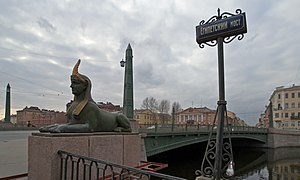Egyptian bridge
Coordinates: 59 ° 55 ′ 2 ″ N , 30 ° 17 ′ 50 ″ E
| Egyptian bridge | ||
|---|---|---|
| Egyptian bridge | ||
| Official name | Египетский мост | |
| use | Pedestrians, bicycles, cars | |
| Crossing of | Fontanka | |
| place | Saint Petersburg , (Russia) | |
| overall length | 46 m | |
| width | 27 m | |
| opening | 1826 (chain bridge), 1955 (metal) |
|
| closure | 1905 (chain bridge) | |
| location | ||
|
|
||
The Egyptian Bridge ( Russian Египетский мост ) in Saint Petersburg leads Lermontov Avenue across the Fontanka River .
Chain bridge
The original Chain Bridge was a notable monument from the early 19th century . It was built by the builders Wilhelm von Traitteur and Christianowicz from 1825 to 1826. Four granite blocks were set up at the ends, adorned with cast iron sphinx figures by the sculptor Pavel Petrovich Sokolov and hexagonal lanterns. The cast iron entrance gates at both ends of the bridge served as a suspension for the suspension chains. They were decorated with Egyptian motifs and numerous hieroglyphics .
Wilhelm von Traitteur also built the Greifenbrücke and the Löwenbrücke at the same time , which are also equipped with figures by Sokolow.
The Egyptian Bridge, designed for pedestrians and horse-drawn carts, collapsed on January 20, 1905 when a cavalry squadron crossed the bridge. The cause was a broken chain. All 60 soldiers who were carried along were rescued, but several horses drowned in the accident.
Arch bridge
At least 17 different plans were drafted before a decision was made to rebuild a bridge on the same site. The arch bridge, built in 1955, was designed by W. Wassilkowski and P. Areschew. Some of the decorations used, such as the sphinx figures, survived the collapse of the chain bridge undamaged and were reused.
See also
Web links
- Detailed information about the Egyptian Bridge near Mosty Sankt Peterburga (Russian)
- Egyptian bridge. In: Structurae (chain bridge)
- Egyptian bridge. In: Structurae (arch bridge)


